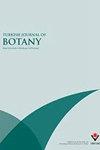印度Parmotrema地衣属内地衣真菌的多样性
IF 1.5
4区 生物学
Q3 PLANT SCIENCES
引用次数: 0
摘要
:地衣是一组未经探索的真菌物种的生态位,它们生活在其铊内,不会引起任何明显的症状,这类真菌被称为内地衣真菌。本研究的目的是检查Parmotrema地衣属内地衣真菌的多样性。该研究共从15种Parmotrema中分离出450株地衣内生真菌(ELF)。其中,利用ITS序列鉴定出73株产孢菌株,共鉴定出23属47种。真菌的系统发育组合包括Sordariomycetes(84.50%)、Dothideomyctes(5.63%)、Eurotiomyces(7.04%)、Pezizomyces(1.40%)和Agaricomyces(1.4%)。此外,水草和白花蛇舌草的最大定殖率为1.55%,相对频率为0.148。索拉森相似系数在哈巴比亚努姆和尼尔根塞之间最高,为0.36。该研究遇到了一些真菌分类群,如元宝环、辐射Coprinellus radians、Cladorhinum sp.、rhytidia Plectania、rabenhorstii Fimetariella和早期未被报道为地衣内生真菌的中华良菌。本文章由计算机程序翻译,如有差异,请以英文原文为准。
Diversity of endolichenic fungi within lichen genus Parmotrema from India
: The lichens serve as an ecological niche for a group of unexplored fungal species residing inside their thallus without causing any noticeable symptoms and such fungi are termed as endolichenic fungi. The objective of the current study is to check the endolichenic fungal diversity within lichen genus Parmotrema. The study resulted in a total of 450 endolichenic fungi (ELF) isolates from 15 species of Parmotrema . Out of these, 73 sporulating isolates were identified using ITS sequences which resulted in 47 species under 23 genera. The phylogenetic assemblage of the fungi comprised Sordariomycetes (84.50%), Dothideomycetes (5.63%), Eurotiomycetes (7.04%), Pezizomycetes (1.40%), and Agaricomycetes (1.40%). Daldinia eschscholtzii , Xylaria feejeensis , Nemania diffusa , Annulohypoxylon truncatum , and Nigrospora sphaerica were frequently occurring isolates inhabiting at least five different species of Parmotrema. Furthermore, Daldinia eschscholtzii and Nemania diffusa were found to be with maximum colonization rate of 1.55% and relative frequency of 0.148. Sorenson’s similarity coefficient was found to be highest between P. hababianum and P. nilgherrense with 0.36. The study encountered fungal taxa such as Annulohypoxylon truncatum , Coprinellus radians , Cladorrhinum sp., Plectania rhytidia , Fimetariella rabenhorstii , and Liangia sinensis earlier not reported as endolichenic fungi.
求助全文
通过发布文献求助,成功后即可免费获取论文全文。
去求助
来源期刊

Turkish Journal of Botany
PLANT SCIENCES-
CiteScore
2.90
自引率
5.60%
发文量
31
审稿时长
6-12 weeks
期刊介绍:
The Turkish Journal of Botany is published electronically 6 times a year by the Scientific and Technological Research Council of Turkey (TÜBİTAK) and accepts manuscripts (in English) covering all areas of plant biology (including genetics, evolution, systematics, structure, function, development, diversity, conservation biology, biogeography, paleobotany, ontogeny, functional morphology, ecology, reproductive biology, and pollination biology), all levels of organisation (molecular to ecosystem), and all plant groups and allied organisms (algae, fungi, and lichens). Authors are required to frame their research questions and discuss their results in terms of major questions in plant biology. In general, papers that are too narrowly focused, purely descriptive, or broad surveys, or that contain only preliminary data or natural history, will not be considered (*).
The following types of article will be considered:
1. Research articles: Original research in various fields of botany will be evaluated as research articles.
2. Research notes: These include articles such as preliminary notes on a study or manuscripts on the morphological, anatomical, cytological, physiological, biochemical, and other properties of plant, algae, lichen and fungi species.
3. Reviews: Reviews of recent developments, improvements, discoveries, and ideas in various fields of botany.
4. Letters to the editor: These include opinions, comments relating to the publishing policy of the Turkish Journal of Botany, news, and suggestions. Letters should not exceed one journal page.
(*) 1. Raw floristic lists (of algae, lichens, fungi, or plants), species descriptions, chorological studies, and plant sociology studies without any additional independent approaches.
2. Comparative morphology and anatomy studies (that do not cover a family, tribe, subtribe, genus, subgenus, section, subsection, or species complexes with taxonomical problems) without one or more independent additional approaches such as phylogenetical, micromorphological, chromosomal and anatomical analyses.
3. Revisions of family, tribe, genus, subgenus, section, subsection, or species complexes without any original outputs such as taxonomical status changes, IUCN categories, and phenological and ecological analyses.
4. New taxa of all plants without any additional independent approaches such as phylogenetical, ecological, chromosomal, chorological and correlational analyses in addition to a detailed macro- and micro-morphological descriptions with quality field and microscopic illustrations of taxonomically important structures and identification key in the taxonomic group.
New records of all plants without any additional independent approaches such as phylogenetical, ecological, chromosomal, chorological and correlational analyses in addition to a detailed macro- and micro-morphological descriptions with quality field and microscopic illustrations of taxonomically important structures and identification key in the taxonomic group may be accepted for peer review if they contain 3 or more new records or taxonomical status update, such as lectotypification, new combinations, transfers, revivals and synonyms.
5. New taxa of algae, lichens, and fungi without any additional independent approaches such as phylogenetical, ecological, chromosomal, chorological and correlational analyses in addition to a detailed macro- and micro-morphological descriptions with quality field and microscopic illustrations of taxonomically important structures and identification key in the taxonomic group.
New records of algae, lichens, and fungi without any additional independent approaches such as phylogenetical, ecological, chromosomal, chorological and correlational analyses in addition to a detailed macro- and micro-morphological descriptions with quality field and microscopic illustrations of taxonomically important structures and identification key in the taxonomic group may be accepted for peer review if they contain 5 or more new records or taxonomical status update, such as lectotypification, new combinations, transfers, revivals and synonyms.
 求助内容:
求助内容: 应助结果提醒方式:
应助结果提醒方式:


